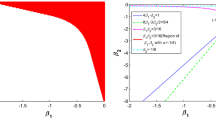Abstract
A fast finite difference method is developed for solving 4th order partial differential equations with discontinuous coefficients across an arbitrary interface. The method is based on an augmented approach by introducing an intermediate (augmented variable) boundary condition \(\varDelta u|_{\partial \varOmega }\) along the boundary so that the problem can be treated as two separated Poisson equations with jumps in the source terms along the interface. Thus a fast Poisson solver can be utilized, which makes the proposed method fast. The augmented variable should be chosen such that the original boundary condition \(\frac{\partial u}{\partial n}|_{\partial \varOmega }\) is satisfied. In discretization, the augmented variable is solved first using the Schur complement associated with the method. The proposed method is probably the first finite difference method for such an interface problem although the paper is partially motivated by the immersed finite element method (Lin et al in J Comput Appl Math 235(13):3953–3964, 2011) for such a problem. Numerical experiments against analytic solutions show that the computed solution using the proposed method has second order accuracy (convergence) in the maximum norm. Numerical results and analysis are also presented for various jump ratios and arbitrary interfaces.


Similar content being viewed by others
Notes
There is a typo in the paper as we have confirmed with the authors. The number 25 in the second term on the last line on page 3962 should be number 5.
References
Beale, J.T., Layton, A.T.: On the accuracy of finite difference methods for elliptic problems with interfaces. Commun. Appl. Math. Comput. Sci. 1, 91–119 (2006)
Brenner, S.C.: An optimal-order nonconforming multigrid method for the biharmonic equation. SIAM J. Numer. Anal. 26, 1124–1138 (1989)
Chen, G., Li, Z., Lin, P.: A fast finite difference method for biharmonic equations on irregular domains. Adv. Comput. Math. 29, 113–133 (2008)
Davini, C., Pitacco, I.: An unconstrained mixed method for the biharmonic problem. SIAM J. Numer. Anal. 38, 820–836 (2000)
Greenbaum, A., Greengard, L., Mayo, A.: On the numerical-solution of the biharmonic equation in the plane. Physica D 60, 216–225 (1992)
Hanisch, M.R.: Multigrid preconditioning for the biharmonic Dirichlet problem. SIAM J. Numer. Anal. 30(1), 184–214 (1993)
Johnson, C.: Numerical Solution of Partial Differential Equations by the Finite Element Method. Cambridge University Press, Cambridge (1987)
Li, Z.: A fast iterative algorithm for elliptic interface problems. SIAM J. Numer. Anal. 35, 230–254 (1998)
Li, Z.: IIMPACK: A collection of fortran codes for interface problems. Anonymous ftp at ftp.ncsu.edu under the directory: /pub/math/zhilin/Package and http://www4.ncsu.edu/~zhilin/IIM, last updated: 2008
Li, Z., Ito, K.: Maximum principle preserving schemes for interface problems with discontinuous coefficients. SIAM J. Sci. Comput. 23, 1225–1242 (2001)
Li, Z., Ito, K.: The Immersed Interface Method—Numerical Solutions of PDEs Involving Interfaces and Irregular Domains. SIAM Frontier Series in Applied Mathematics, FR33, 2006
Li, Z., Ito, K., Lai, M.-C.: An augmented approach for Stokes equations with a discontinuous viscosity and singular forces. Comput. Fluids 36, 622–635 (2007)
Li, Z., Ji, H., Chen, X.: Accurate solution and gradient computation for elliptic interface problems with variable coefficients. SIAM J. Numer. Anal. 55(2), 570–597 (2017)
Li, Z., Zhao, H., Gao, H.: A numerical study of electro-migration voiding by evolving level set functions on a fixed Cartesian grid. J. Comput. Phys. 152, 281–304 (1999)
Lin, T., Lin, Y., Sun, W.-W., Wang, Z.: Immersed finite element methods for 4th order differential equations. J. Comput. Appl. Math. 235(13), 3953–3964 (2011)
Mayo, A.: The fast solution of Poisson’s and the biharmonic equations on irregular regions. SIAM J. Numer. Anal. 21, 285–299 (1984)
Mayo, A., Greenbaum, A.: Fast parallel iterative solution of Poisson’s and the biharmonic equations on irregular regions. SIAM J. Sci. Stat. Comput. 13, 101–118 (1992)
Thatcher, R.W.: A least squares method for solving biharmonic problems. SIAM J. Numer. Anal. 38, 1523–1539 (2000)
Timoshenko, S., Goodier, J.: Theory of Elasticity. McGraw-Hill Co., New York (1970)
Acknowledgements
The first author is partially supported by US NSF Grant DMS-1522768, CNSF Grant 11371199, and 11471166. The second author is partially supported by CNSF Grant 11371199, 11671209, and 11671210. We would like to thank Dr. Tao Lin for valuable discussions. We would also like to thank the referees for constructive and helpful comments and suggestions.
Author information
Authors and Affiliations
Corresponding author
Additional information
Dedicated to Professor Chi-Wang Shu on the occasion of his 60th birthday.
Rights and permissions
About this article
Cite this article
Li, Z., Qin, F. An Augmented Method for 4th Order PDEs with Discontinuous Coefficients. J Sci Comput 73, 968–979 (2017). https://doi.org/10.1007/s10915-017-0487-7
Received:
Revised:
Accepted:
Published:
Issue Date:
DOI: https://doi.org/10.1007/s10915-017-0487-7




